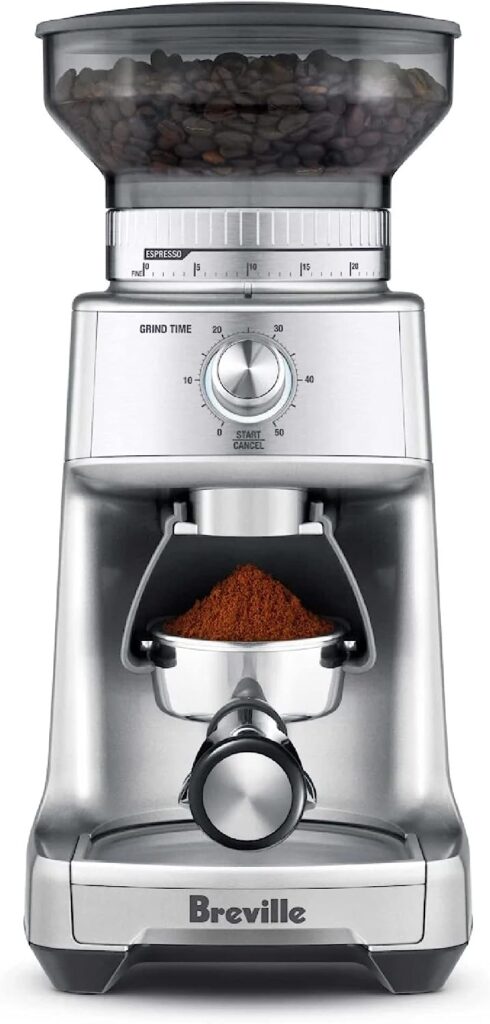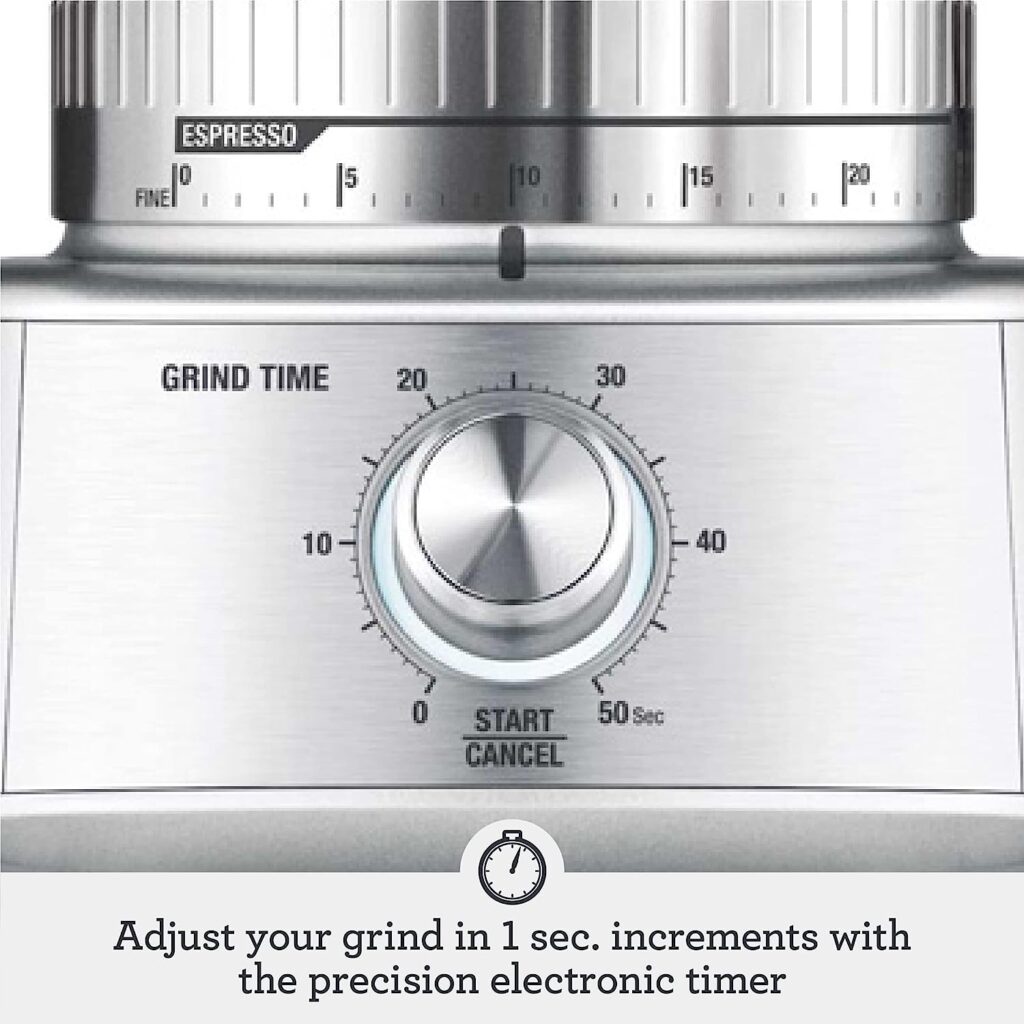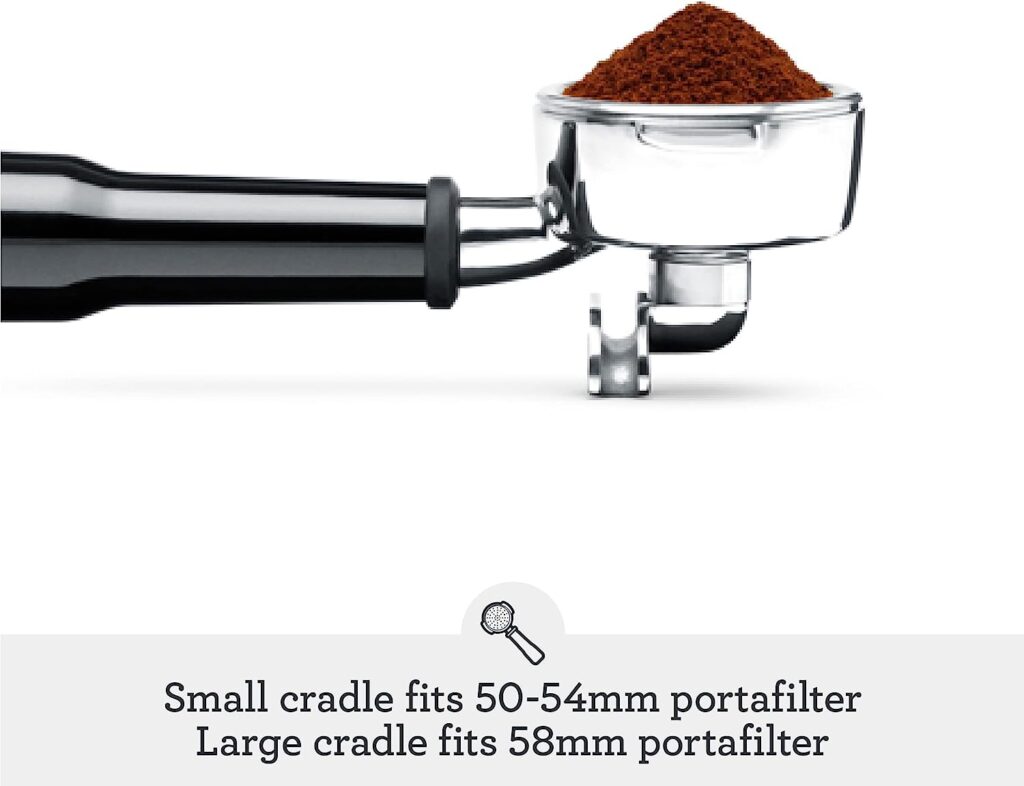Having a great coffee grinder as part of your setup is a way to make sure that every single cup you brew is as fresh as possible. As James Hoffman says quite often – we go to the effort of grinding black pepper freshly for our food, doing the same for coffee is just a simple, easy way to boost the flavor in every single cup!

This grinder is a particularly nice one – we’re big fans of Breville and Sage here at Raj’s Coffee Co., and this grinder is no exception to that rule. In this article, we’re going to talk a little about what makes this grinder great, and what it might want to improve to do a little better.
What does it do well?
The grinder is obviously designed to specialize in a whole heap of espresso-based uses. The cradle itself is interchangeable, allowing for different sizes of portafilter to be rested within, allowing you to minimize waste while speedily grinding and brewing a steaming cup of coffee.
This means that the burrs are well-calibrated to grind down to an exceptional level of fineness. We wouldn’t want to say that the grinder could quite manage Turkish-level fineness, but it’s damn close.
The grinder also makes great use of different physical buttons. This might be a slightly strange opinion, but I’m personally in love with the feel of physical buttons, rather than a touch screen – there’s something really engaging about the tactile feedback that you get from a button!
In this grinder, in particular, this feedback is very noticeable. The main way you interact with the machine is through a dial which serves several purposes.
Principally, the dial is pressed to start the grinding process and responds well with a satisfying click every time it’s pressed. This can also be used to cancel the grinding process, should the need arise – grinders can be a dangerous piece of equipment, so it’s always good to know that there’s an easy-to-use stop button on hand.
Secondly, that dial also serves to increase or decrease the time that the grinder itself spends grinding. It’s stepped in one-second increments and ranged from zero to fifty. This allows you a great deal of control, allowing for the perfect dosage in your espresso machine.
What does it do poorly?

That point about the grinding duration leads us quite well into the disadvantages of the grinder. Simply put, I’ve never before seen a high-end grinder like this one that chooses to start and end the grinding based on time. This is a really unusual choice!
Typically, the grinding will be determined by some kind of pre-set interval, the length of which determines how much coffee is coming out of your grinder. This is very functional, as someone that doesn’t want to weigh their portafilter too intently can easily set it and walk away for a few seconds.
Alternatively, the grinding might be determined by a variation on a dead man’s switch – as long as a button is being pressed, the coffee is being ground. This is very useful as it allows you incredible control over your coffee grinding, and you can easily move the portafilter to your scales and weigh out how much coffee you’ve ground.
The stepped timer, though, sort of offers the worst of both worlds. You lose the control over the throughput of the grinder by handing over the control to a timer. You also lose the reliability of uniform dispensing by making the grinder increment changes so very small.
Of course, you could still make a great cup of coffee this way, you would just need to do a little experimentation and math. Personally, I wouldn’t want to do that before I’ve had a cup of coffee in the morning, but if it seems ideal to you, then I wouldn’t want to stop you.
The only other fault to pick with this grinder is just something a little more nitpicky. The design of the cradle is such that it can be totally removed, allowing you to place your coffee filter underneath, and grind directly into that.
However, the rest of the form of the grinder is designed to accommodate a portafilter, which is typically a fairly uniform size. Therefore, there might not be enough room for your filter in particular under the grounds dispenser.
There is an obvious solution to this problem – grind it into a small bowl and then dispense it into your coffee filter. However, this is another step and another thing to wash every time you make coffee. Personally, I’d find it a little irritating every time!
What’s the verdict?
Well, the final decision is a pretty simple one – I like it! If you’ve got an espresso machine that doesn’t have a built-in grinder, then you’ll be looking for a standalone espresso grinder for yourself.

That’s all well and good, but those grinders can get exceptionally pricey – if you’re on a budget, it can be hard to rationalize.
This grinder offers very good grinding to an excellent consistency at a fairly reasonable price point. Granted, you’re unlikely to buy a dozen of them, but it’s more reasonable than some of the very expensive alternatives.
I might not suggest that you pick up this grinder for filter or press brewing. While it certainly could handle these tasks, it might not be so good as to choose this over other options. It’s certainly a grinder designed with espresso in mind, which therefore lends itself to an impressive ability for espresso grinding, with which there will always be some loss with regards to coarser grinding.
So, to sum up, this grinder is something that I might recommend for anyone that has a standalone espresso machine and is in the market for a grinder that might boost their coffee beyond pre-ground! One thing’s for certain, though – I would definitely make sure your espresso machine matches the beautiful brushed steel of this grinder!

